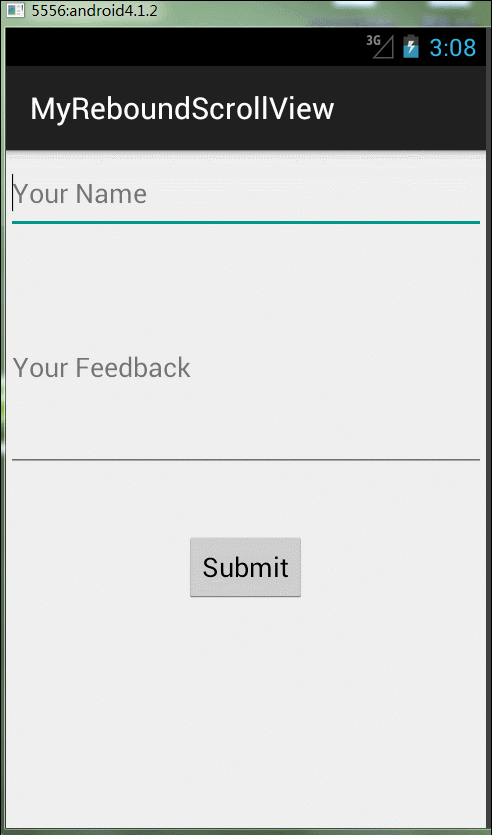用过iphone的朋友相信都体验过页面上拉下拉有一个弹性的效果,使用起来用户体验很好;Android并没有给我们封装这样一个效果,我们来看下在Android里如何实现这个效果。先看效果,感觉有些时候还是蛮实用的。

思路:其实原理很简单,实现一个自定义的Scrollview方法(来自网上大神),然后在布局文件中使用自定义方法Scrollview就可以了。
代码:
自定义View,继承自Scrollview。MyReboundScrollView类
代码注释非常清楚。
- package com.wj.myreboundscrollview.customview;
- import android.content.Context;
- import android.graphics.Rect;
- import android.util.AttributeSet;
- import android.view.MotionEvent;
- import android.view.View;
- import android.view.animation.TranslateAnimation;
- import android.widget.ScrollView;
- //仿ios可上提下拉的ScrollView
- public class MyReboundScrollView extends ScrollView {
- private static final String TAG = "ElasticScrollView";
- //移动因子, 是一个百分比, 比如手指移动了100px, 那么View就只移动50px
- //目的是达到一个延迟的效果
- private static final float MOVE_FACTOR = 0.5f;
- //松开手指后, 界面回到正常位置需要的动画时间
- private static final int ANIM_TIME = 100;
- //ScrollView的子View, 也是ScrollView的唯一一个子View
- private View contentView;
- //手指按下时的Y值, 用于在移动时计算移动距离
- //如果按下时不能上拉和下拉, 会在手指移动时更新为当前手指的Y值
- private float startY;
- //用于记录正常的布局位置
- private Rect originalRect = new Rect();
- //手指按下时记录是否可以继续下拉
- private boolean canPullDown = false;
- //手指按下时记录是否可以继续上拉
- private boolean canPullUp = false;
- //在手指滑动的过程中记录是否移动了布局
- private boolean isMoved = false;
- public MyReboundScrollView(Context context) {
- super(context);
- }
- public MyReboundScrollView(Context context, AttributeSet attrs) {
- super(context, attrs);
- }
- @Override
- protected void onFinishInflate() {
- if (getChildCount() > 0) {
- contentView = getChildAt(0);
- }
- }
- @Override
- protected void onLayout(boolean changed, int l, int t, int r, int b) {
- super.onLayout(changed, l, t, r, b);
- if(contentView == null) return;
- //ScrollView中的唯一子控件的位置信息, 这个位置信息在整个控件的生命周期中保持不变
- originalRect.set(contentView.getLeft(), contentView.getTop(), contentView
- .getRight(), contentView.getBottom());
- }
- //在触摸事件中, 处理上拉和下拉的逻辑
- @Override
- public boolean dispatchTouchEvent(MotionEvent ev) {
- if (contentView == null) {
- return super.dispatchTouchEvent(ev);
- }
- int action = ev.getAction();
- switch (action) {
- case MotionEvent.ACTION_DOWN:
- //判断是否可以上拉和下拉
- canPullDown = isCanPullDown();
- canPullUp = isCanPullUp();
- //记录按下时的Y值
- startY = ev.getY();
- break;
- case MotionEvent.ACTION_UP:
- if(!isMoved) break; //如果没有移动布局, 则跳过执行
- // 开启动画
- TranslateAnimation anim = new TranslateAnimation(0, 0, contentView.getTop(),
- originalRect.top);
- anim.setDuration(ANIM_TIME);
- contentView.startAnimation(anim);
- // 设置回到正常的布局位置
- contentView.layout(originalRect.left, originalRect.top,
- originalRect.right, originalRect.bottom);
- //将标志位设回false
- canPullDown = false;
- canPullUp = false;
- isMoved = false;
- break;
- case MotionEvent.ACTION_MOVE:
- //在移动的过程中, 既没有滚动到可以上拉的程度, 也没有滚动到可以下拉的程度
- if(!canPullDown && !canPullUp) {
- startY = ev.getY();
- canPullDown = isCanPullDown();
- canPullUp = isCanPullUp();
- break;
- }
- //计算手指移动的距离
- float nowY = ev.getY();
- int deltaY = (int) (nowY - startY);
- //是否应该移动布局
- boolean shouldMove =
- (canPullDown && deltaY > 0) //可以下拉, 并且手指向下移动
- || (canPullUp && deltaY< 0) //可以上拉, 并且手指向上移动
- || (canPullUp && canPullDown); //既可以上拉也可以下拉(这种情况出现在ScrollView包裹的控件比ScrollView还小)
- if(shouldMove){
- //计算偏移量
- int offset = (int)(deltaY * MOVE_FACTOR);
- //随着手指的移动而移动布局
- contentView.layout(originalRect.left, originalRect.top + offset,
- originalRect.right, originalRect.bottom + offset);
- isMoved = true; //记录移动了布局
- }
- break;
- default:
- break;
- }
- return super.dispatchTouchEvent(ev);
- }
- //判断是否滚动到顶部
- private boolean isCanPullDown() {
- return getScrollY() == 0 ||
- contentView.getHeight() < getHeight() + getScrollY();
- }
- //判断是否滚动到底部
- private boolean isCanPullUp() {
- return contentView.getHeight() <= getHeight() + getScrollY();
- }
- }
布局文件直接使用
这里直接在外层包裹实现。注意,因为Myreboundscrollview是继承自Scrollview,因此要遵循Scrollview的使用原则,里面只能包含一个LinearLayout,所以无论里面多门复杂的布局,最后我们都要将其包含在一个LinearLayout中。
- <com.wj.myreboundscrollview.customview.MyReboundScrollView
- xmlns:android="http://schemas.android.com/apk/res/android"
- xmlns:tools="http://schemas.android.com/tools"
- android:layout_width="match_parent"
- android:layout_height="match_parent"
- tools:context=".MainActivity"
- android:orientation="vertical">
- <LinearLayout
- android:layout_width="match_parent"
- android:layout_height="wrap_content"
- android:orientation="vertical">
- <EditText
- android:id="@+id/et_name"
- android:layout_width="match_parent"
- android:layout_height="wrap_content"
- android:layout_marginTop="12dip"
- android:hint="Your Name"/>
- <EditText
- android:id="@+id/et_feedback"
- android:layout_width="match_parent"
- android:layout_height="wrap_content"
- android:layout_marginTop="32dip"
- android:hint="Your Feedback"
- android:lines="5"/>
- <Button
- android:id="@+id/btn_submit"
- android:layout_width="wrap_content"
- android:layout_height="wrap_content"
- android:layout_gravity="center"
- android:layout_marginTop="42dip"
- android:text="Submit"
- android:onClick="submit"/>
- </LinearLayout>
- </com.wj.myreboundscrollview.customview.MyReboundScrollView>
ok,功能实现,效果也演示,具体需要使用直接拿来用就可以。
如果觉得对你有帮助,顶起留言啊!





















 1559
1559

 被折叠的 条评论
为什么被折叠?
被折叠的 条评论
为什么被折叠?








